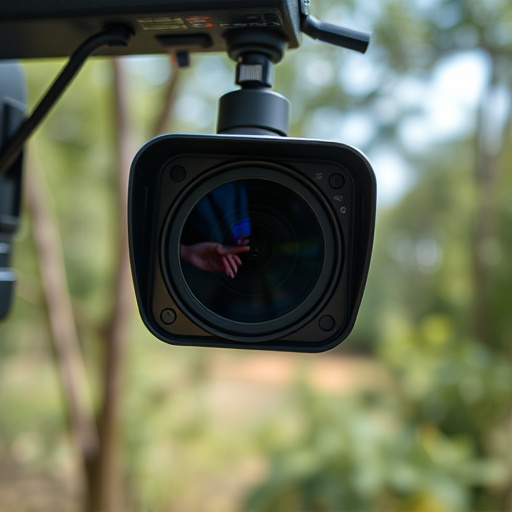Wireless spy camera phone apps have transformed discreet monitoring, allowing smartphone users to control settings, start/stop recording, and view live feeds. These advanced devices capture images or videos wirelessly and transmit them through networks or store them locally. While convenient, their widespread use raises significant privacy concerns. The technology behind these apps involves detecting light reflection anomalies from surfaces like walls and furniture using natural light or the phone's flash, effectively identifying covert surveillance devices without physical damage. Combining this technique with sophisticated algorithms in Wireless Spy Camera Phone Apps significantly enhances security and privacy by detecting subtle camera signals and providing alerts through vibrations or visual cues. Future developments include advanced image processing and machine learning for predictive capabilities, aiming to proactively alert users of potential hideouts.
Uncover the insidious world of hidden spy cameras with our in-depth exploration of a revolutionary detection technique. We delve into the science behind light reflection, a powerful tool to expose covert surveillance devices. Learn how this method, enhanced by wireless spy camera phone apps, allows users to navigate a modern-day enigma. From understanding camera operation to exploring app implementations and limitations, this guide equips you with knowledge to protect your privacy in today’s digital landscape, ensuring folks remain vigilant against lurking eyes.
- Understanding Spy Cameras and Their Operation
- The Science Behind Light Reflection Detection
- Implementing the Technique with Wireless Spy Camera Phone Apps
- Limitations, Countermeasures, and Future Prospects
Understanding Spy Cameras and Their Operation
Spy cameras, also known as hidden cameras, have evolved significantly with advancements in technology, especially with the integration of wireless capabilities and remote control through smartphone apps. These devices are designed to capture images or videos discreetly, often without the knowledge of individuals being monitored. They can be installed in various forms, from small, easily concealed cameras to more sophisticated models mimicking everyday objects like smoke detectors or power outlets. The operation of these devices typically involves a lens that captures light and converts it into an image, which is then transmitted through wireless networks or stored locally for later retrieval.
Wireless spy camera phone apps have become particularly popular due to their ease of use and real-time monitoring capabilities. Users can remotely control the camera’s settings, start and stop recording, and even view live feeds from their smartphones. This technology raises important privacy concerns, as it allows individuals to secretly record activities without consent. As such, understanding how these devices operate is crucial for both users seeking to protect their privacy and those looking to employ them for security or surveillance purposes.
The Science Behind Light Reflection Detection
The Science Behind Light Reflection Detection involves an intricate interplay of light, angles, and surfaces. When a wireless spy camera is activated, it emits light at specific wavelengths, which then bounces off surrounding objects—walls, ceilings, or even furniture. These reflections carry unique signatures that can be captured and analyzed by specialized apps, like those available on modern smartphone cameras.
The key lies in understanding how light interacts with different materials. Each surface reflects and absorbs light differently, creating patterns of intensity and frequency. By examining these reflections, the Wireless Spy Camera Phone App can detect subtle anomalies indicative of hidden camera activity. This non-invasive technique leverages natural light sources or the phone’s built-in flash to maximize contrast, making it an effective method for identifying covert surveillance devices without causing any physical damage or disruption.
Implementing the Technique with Wireless Spy Camera Phone Apps
Implementing the light reflection technique for spy camera detection in conjunction with wireless spy camera phone apps opens up new possibilities for enhanced security and privacy. These mobile applications, designed to uncover hidden cameras, leverage the app’s built-in camera and advanced processing algorithms to analyse light patterns and reflections. When a potential spy camera is detected, the app can alert users through vibrations or visual cues, allowing them to take immediate action.
Wireless Spy Camera Phone Apps act as powerful tools for individuals and professionals alike, providing an additional layer of protection in both personal and professional settings. By combining traditional light reflection methods with modern technology, these apps ensure that even subtle camera signals are not overlooked, thereby fostering a safer digital environment.
Limitations, Countermeasures, and Future Prospects
Despite its effectiveness in detecting hidden spy cameras, the light reflection technique is not without limitations. One significant challenge is that it may not work optimally in environments with high ambient light or frequent lighting changes. The precision of identifying camera locations can also be impacted by factors like angle of incidence and reflectivity of surfaces, demanding continuous adjustments for accurate results.
To overcome these hurdles, researchers and developers are continually refining the technology. One promising countermeasure involves integrating advanced image processing algorithms into wireless spy camera phone apps. These apps can enhance detection accuracy by analyzing light reflections in real-time, filtering out false positives, and providing more precise data on camera positions. Looking ahead, combining machine learning capabilities with light reflection analysis could lead to even smarter systems, capable of predicting potential camera hideouts and proactively alerting users.
In conclusion, the spy camera detection light reflection technique offers a promising method for identifying hidden cameras, especially with the rise of wireless spy camera phone apps. By understanding how these devices operate and leveraging the science behind light reflection, individuals can now take proactive measures to protect their privacy in today’s digital era. While there are limitations and countermeasures to consider, ongoing research and advancements hold great potential for further enhancing this innovative approach.
